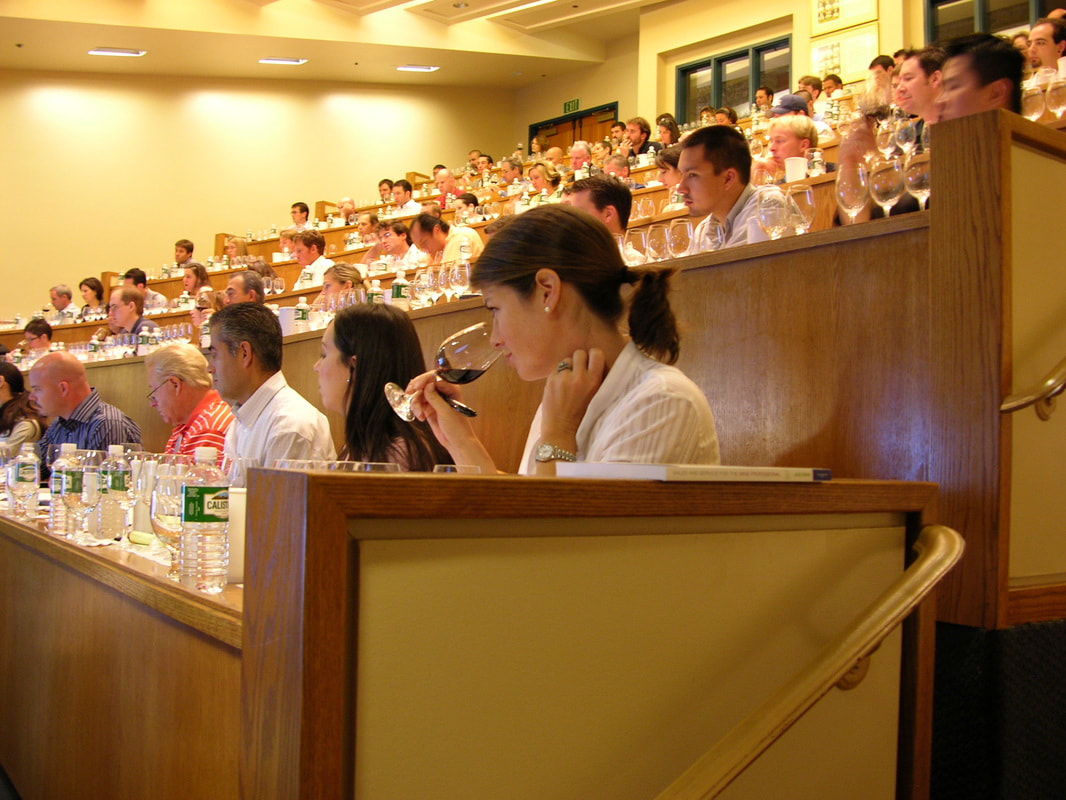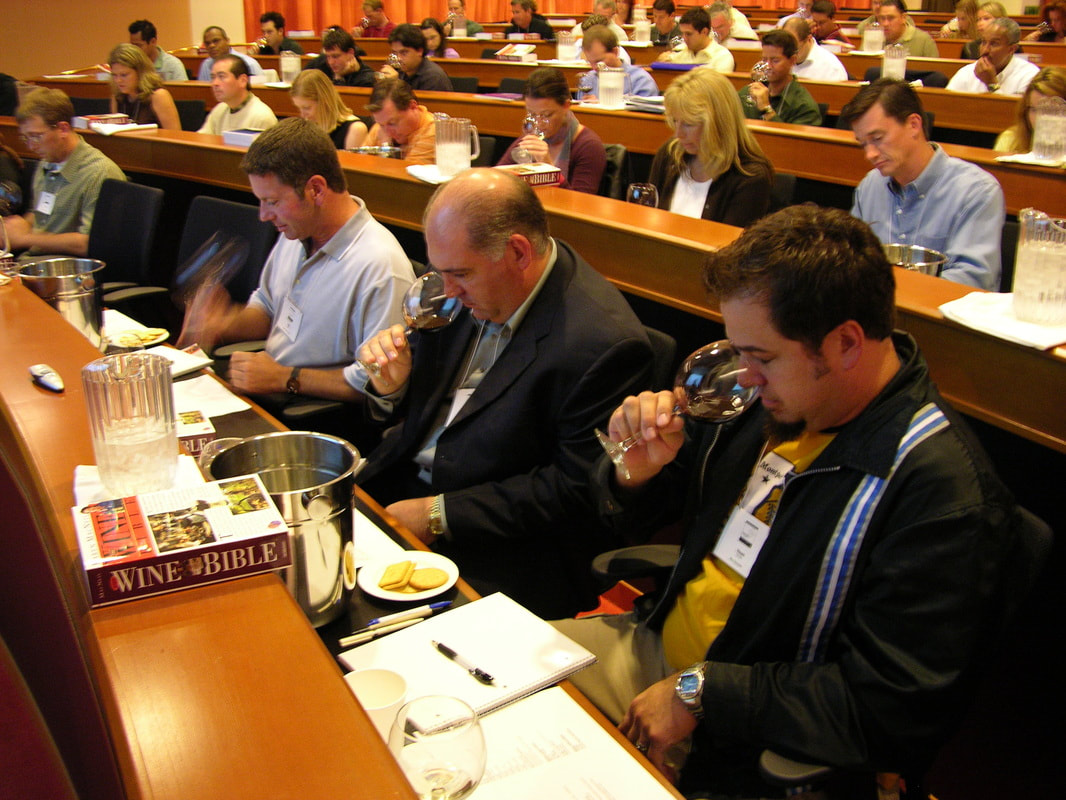Sometimes I think the process of smelling and tasting wine is a lot like playing golf. Both are very complex sequences that involve the use of multiple senses to process a great deal of information in the moment all to achieve a single goal. To point, addressing the golf ball consistently before making a shot in golf is probably the single most important factor for success in the game. Likewise, consistency in technique when picking up a glass to smell wine is incredibly important. I call the process “glassware stance.” Here’s a breakdown of the essential steps.
The Angle of the Glass
Every wine glass has a “best angle” or sweet spot for smelling wine—the angle where the aromatics can be most easily perceived and recognized. To find the best angle, start by placing the glass vertically just underneath your nose and slowly tilt the glass up. Don’t go too far! You’ll inhale the wine. At some point, when the angle of the glass is between 45 and 50 degrees, the aromas of the glass will begin to “sing” and be easy to detect. It’s important to note that different kinds/shapes of glasses (Bordeaux vs. Burgundy stems) have different “best angles.” Remember to check for this every time you pick up a different glass.
Smelling Techniques
Practically every source on tasting I’ve ever read suggests smelling wine using several short and gentle sniffs. I completely agree. The opposite—smelling wine with one prolonged intense hoover/inhalation–is anything but effective. For one, the alcohol in the wine can quickly overwhelm your sense of smell. I call that carpal nasal. It’s also a bit awkward.
Passive vs. Active Inhalation
Most of the human race smells wine by placing the lip of the glass directly on the upper lip just beneath the nose, then sniffing. I call this passive inhalation as it relies almost entirely on orthonasal smelling or, technically speaking, detecting the volatile compounds (aromatics) in a wine by inhaling through the nasal passages. For the record, this doesn’t work for me. It quickly overwhelms my sense of smell. Instead, I use a technique I learned at a Cognac master class decades ago. I call it “active inhalation.”
When smelling wine, I pull the glass away from my face by about a half-inch, open my mouth slightly, and then breathe in (and out) gently through my mouth and nose at the same time. Why does active inhalation potentially work better? It’s due to physiology. There are two methods of smelling—ortho nasal, mentioned above, and retro-nasal, which uses both nasal and oral cavities. What I call “active inhalation” makes use of both ortho and retro-nasal smelling in tandem. It also more than doubles the physiological real estate used to smell. Will it work for you? No guarantees, but it’s definitely worth checking out. To do so, simply try the following:
- Start with the glass resting directly underneath your nose positioned at about a 45° angle.
- Move the glass slowly out to at least an inch away from your nose.
Make sure the glass is also positioned near your mouth. - Open your mouth about ¼ inch.
- Smell the wine breathing gently in–and out–through your mouth and nose at the same time.
- Test the results: are you able to smell better? Does the change make a difference at all? Try going back and forth between smelling with just your nose vs. nose and mouth together.
Give the active inhalation technique a try. It may—or may not—work for you. Again, no guarantees. But I think you’ll find it especially effective when smelling higher alcohol wines like Port and Sherry, as well as spirits.
The last piece of the glassware stance equation is perhaps the most important—and something no one ever talks about, much less teaches. As you put your nose in the glass to focus on all aromatics, you might be aware of the fact that your head and torso tend to go slightly down. You might also notice that as you reach the spot where you can smell the best, your eyes probably end up looking down in front of you either straight ahead, slightly to the left, or even slightly to the right. It’s different for everyone.
This may not seem important, but it’s a vital part of being consistent in starting the internal sequence of smelling wine. The relationship between eye positions and various kinds of sense memory are called “vertical and lateral eye movements” or “eye accessing cues.” I strongly believe that finding your consistent starting eye position is vitally important in becoming a professional taster. Most discover it unconsciously over time with a great deal of repetition. It would therefore seem preferable to find it sooner rather than later. Here are steps to find your starting eye position.
- Stand up—you’ll be able to focus much better than you can when sitting down.
- Pick up the glass and smell the wine.
- While smelling the wine, focus your eyes downward at a 15-20° angle above the floor and straight ahead.
- While continuing to smell the wine, take your free hand and point to the location where your eyes are looking.
- Now move your eyes and free hand together, slowly, from left to center to the right—all the while continuing to smell the wine.
- Gradually find the one place that feels the most comfortable and familiar—it shouldn’t take long to locate it.
- Once you find your “best” starting place, be sure to mark it clearly in your memory.
- This is your starting eye position. Be sure to use it whenever beginning to smell a wine.
Important! Remember that it’s just your starting place. After you begin to examine a wine, your eyes will move to various locations as you analyze it. However, what’s important is that you remember to start in the same place every time. Being aware of your starting eye position is also a priceless resource when taking a tasting exam. It gives you a “reset” place when a wine is proving difficult to describe or identify.
Coda
There are several concepts listed above. For the sake of ease and your sanity, I suggest taking them one at a time and working with them until they seem easy. If something doesn’t seem easy at first, odds are you’re doing it in a way that doesn’t work for your brain. The moment you do find the right way, your brain will let you know immediately. When that happens, make note of it and do it every time going forward. You’ll be glad you did.
Cheers!

